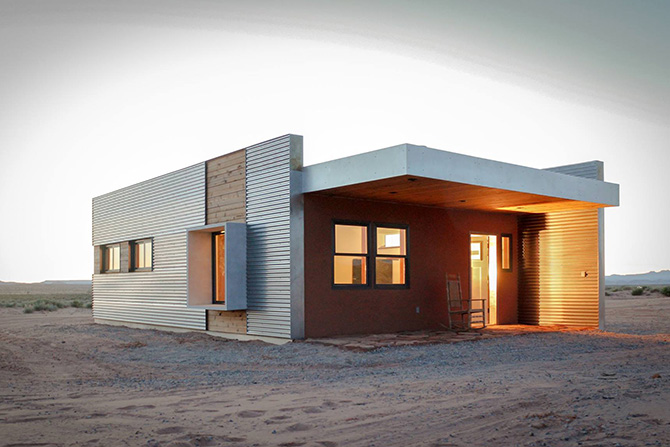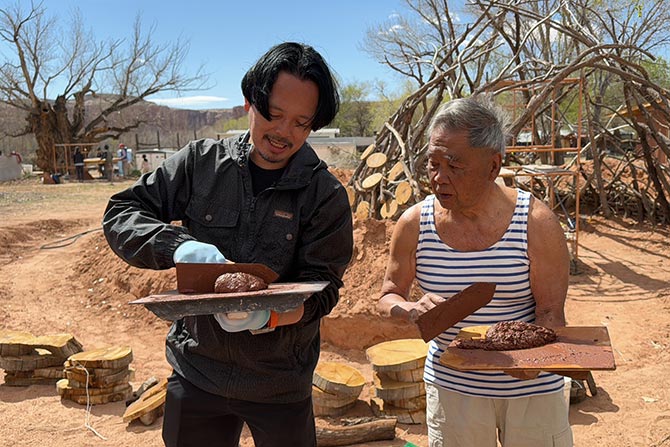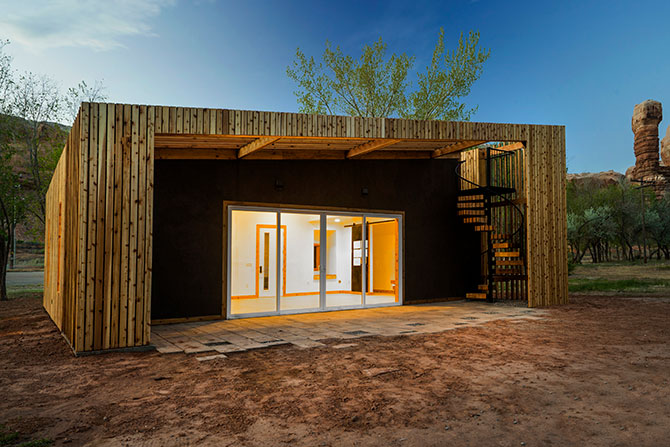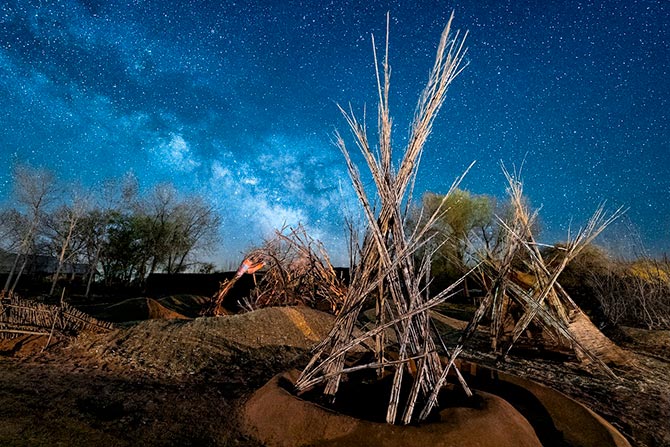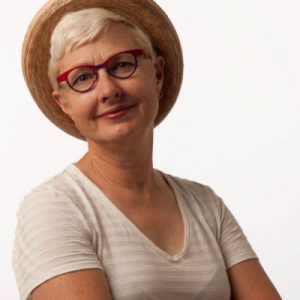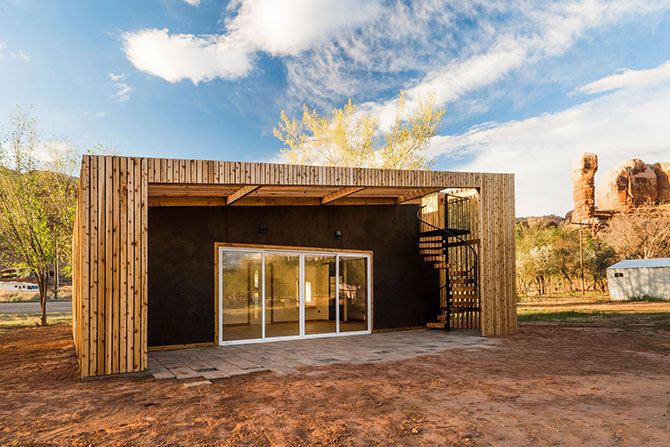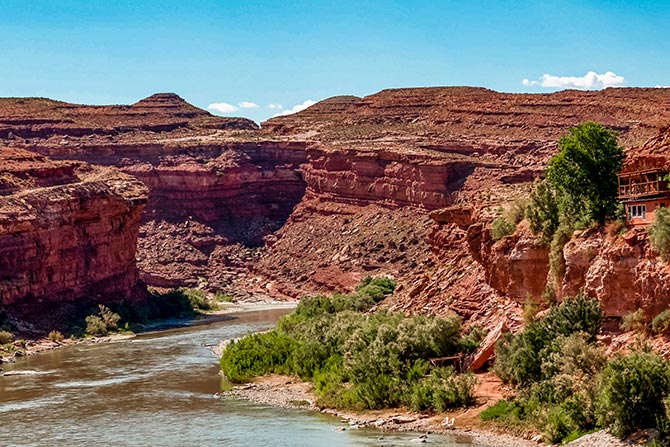“Everyone, rich or poor, deserves a shelter for the soul.” – Samuel Mockbee
DesignBuildUTAH@Bluff is celebrating 20 years of educating architecture students, providing innovative design and, along the way, creating an impressive body of work that is occupied by people of the Navajo Nation. The program has had a profound impact on designers, builders and users. The product, which largely is housing that is sustainable, low-maintenance and totally off-grid, is an important contribution to a tribal community in need of affordable housing. The student experience is priceless. It teaches design creativity within limitations, collaboration between very different cultures, and the hard skills necessary to take ideas off the page and put them into the ground.
How It Started
DesignBuildUTAH@Bluff is the brainchild of Hank Louis, a journalist turned writer/architect, who was driving through Utah when his car broke down. He stayed to ski and didn’t leave. Louis studied at the University of Utah’s School of Architecture to help him build his own home in Costa Rica. In the 90s, Louis happened upon the work of Samuel Mockbee in trade magazines. He was impressed by Mockbee’s Rural Studio program, which provided practical training for architecture students in underserved areas of the southern United States where their work could address the problems of poverty and substandard housing. Inspired by Mockbee’s philosophy and excited by the possibilities, Louis studied with Mockbee at Auburn University to help determine how he might create a similar program in Utah.
Louis had friends who taught at the University of Utah and, in 2000, he collaborated with them to start a graduate class that created small design-build projects in Summit County and Park City, like a bandstand and a pavilion. This “pilot” course was effective, and in 2004 the program moved to the next level. Louis had bought land near Bluff, Utah, and once there, he saw a need for housing on the nearby Navajo reservation. Louis partnered the University with the Navajo Nation to create an immersive experiential learning program that not only gives architecture students the hands-on experience of designing and building structures, but that could help address the reservation’s housing shortage. Every year they could add another, very different, home to the reservation.
Louis recognized that since the tribe already owned the land, building would be less expensive. With less municipal influence and therefore less red tape, there could be an opportunity to experiment architecturally and employ progressive and environmentally responsible design strategies. The inevitable byproduct of this endeavor is that it also teaches students to collaborate with clients to address their needs and how to build empathetic design-build teams.
Twenty years into this experiment, the program has received national recognition and students have completed 23 design-build housing projects, many of which have won design awards.
Alumni speak to how the program is life altering. Diane Kayembe said, “[DesignBuildUTAH@Bluff] was a once-in-a-lifetime experience that improved the trajectory of my personal and professional life. I have been able to translate and apply the lessons and skills learned while in the program. I am grateful and proud that I took the jump and participated in this amazing opportunity.”
At a recent Bluff celebration, alums wrote on a wall that, “I built unforgettable memories, learning lifelong skills with an amazing cohort.” (signed Design Build Bitches, a class of five female students). Others said, “The program breaks down the division between design and labor,” and highlighted “learning about construction and detailing in a whole new way” and “making spaces out of spaces and enhancing the human experiences of them.”
So How Does It Actually Work?
Annually, Hiroko Yamamoto and Atsushi Yamamoto, the co-directors of DesignBuildUTAH, work with local tribal chapters to select from applicants the family who will be the beneficiary of a single-family home that is appropriate for the site, the users and the tribal nation, and which can be passed from one generation to the next.
Design
During the summer, the graduate students study the architectural vernacular of the southern Utah tribal area. They then design the (approx.) 1,500 sq. ft. house, from pre-schematics through construction and project management documents.
The beneficiary clients are an integral part of the process, and are encouraged to be part of design activities as much as possible. They meet and talk about clients’ preferences and requirements. Students get to know the client, their needs, their dreams and their aesthetics. Each home has a distinct design concept, tailored to the family, the site, and the culture of the reservation.
Green-build techniques are encouraged. Designers consider a myriad of potential environmentally friendly technologies including passive solar, rainwater catchment, permaculture, earthen plaster, rammed earth, straw bale construction, cellulose insulation, and Iycnene foam. Materiality is a critical component of any project design, and Bluff projects must be particularly attuned to the remote desert environment, both aesthetically and practically. As a result, designs have integrated materials reclaimed from the surrounding landscape like natural clay and riverbed reed. Serving the pragmatic nature of the program, the designers also must incorporate contributions of donated and recycled materials like lumber, windows, doors, and appliances.
Build
The documents are completed by the end of the college’s summer session, and in August the grad students move 5 ½ hours from Salt Lake to live on the Bluff Campus. They occupy the Historic Farmhouse: the class lives together, eats together and builds together. They drive to the site early in the morning and often work 10 to 12 hours a day. The site is very remote and everything has to be imported and all waste is exported. Learning from on-site instructors and contractors, they study and apply real-life construction skills that can range from staging materials to installing finishes. Meanwhile, the students also take other classes, such as Southwest Culture and a Research and Theory course by remote learning.
By the end of the four-month semester, the project is delivered and the students return to the Salt Lake Campus. Typically, they are very bonded and have built a community, as one student said, “physically, metaphorically and personally.”
DesignBuildUtah@SLC
Not all students have the flexibility to go to Bluff. Recognizing this, the University of Utah has added DesignBuildUtah@SLC to its curriculum. It is now in its eighth year. Located on the Salt Lake City campus, this course focuses on materials and experimentation and works on a different scale than a house. It is an intensive experience that begins with a summer session then moves into a rigorous fall design semester.
Collaborating with the local architects, students work on community-engaged projects. Mentored by the faculty and other professionals, they study high performance methods of design and fabrication. Recent projects have included affordable housing prototypes, a tiny house on wheels for The Other Side Village, a master-planned neighborhood that provides housing for people who have experienced chronic homelessness. This year, DesignBuildUtah@SLC is exploring possibilities of working with the Utah Transit Authority.
Both educational programs are made possible by the Herculean efforts of the University, the partner communities, alumni, and particularly the many people and organizations who make contributions. The DesignBuildUtah website says that the programs are “committed to teaching the practices of creative critical thinking, community engagement, design excellence, ecological resilience, citizenship, leadership/collaboration, exploration and social equity.”
By any measurement, DesignBuildUTAH has brought Mockbee’s philosophy and Louis’ vision to life in a program that serves the students and communities alike with experiences and projects that will last for generations.
